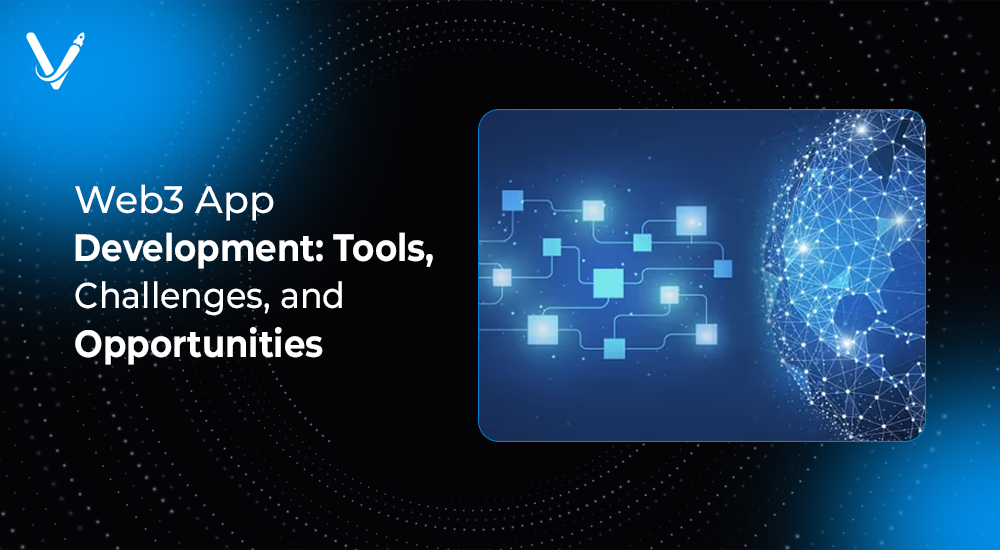Web3 App Development: Tools, Challenges, and Opportunities


- Jul 23, 2025



The internet is undergoing a paradigm shift—an evolution from centralized control to decentralized empowerment. As this transformation unfolds, Web3 app development is emerging as the backbone of this new digital frontier. Developers, startups, and enterprises alike are racing to build Web3 applications that unlock ownership, transparency, and trust across industries.
This article dives deep into the evolving landscape of Web3, focusing on the essential Web3 development tools, major challenges developers face, and the vast opportunities available for forward-thinking teams. If you're a Web3 developer, startup founder, or enterprise leader exploring Web 3 solutions, this guide will help you understand the technical stack, avoid pitfalls, and maximize your innovation potential.
Web3 represents the decentralized internet built on blockchain technology. Unlike Web2, where data and applications are controlled by centralized entities (like Facebook or Google), Web3 gives control back to users using technologies like smart contracts, distributed ledgers, and crypto wallets.
At its core, Web3 embraces:
From NFT marketplaces to DeFi platforms, Web3 apps are reshaping how we think about finance, gaming, identity, and more.
The rise of Web3 development companies signals a significant shift in global demand. As regulatory clarity improves and blockchain infrastructure becomes more scalable, businesses are integrating Web3 apps to attract tech-savvy users and investors. Here’s why this matters:
The momentum behind Web3 is undeniable. But building robust Web3 applications isn’t easy—it requires a deep understanding of cutting-edge tools and architectural shifts.
A typical Web3 application has three major layers:
The interaction flow looks like this:
User (via Wallet) ↔ Frontend (UI) ↔ Smart Contracts ↔ Blockchain
To succeed in Web3 app development, the right tools are non-negotiable. Here are the must-have tools for modern Web3 devs:
Frameworks:
Choosing the right chain is crucial for scalability and cost-effectiveness.
These Web3 development tools empower teams to build scalable, secure, and user-centric dApps efficiently.
Even with robust tools, Web3 devs encounter unique challenges that differ from traditional app development.
Blockchain is still maturing, and experienced Web3 developers are in short supply. Writing secure, gas-optimized smart contracts requires a steep learning curve.
Bugs in smart contracts can be catastrophic. Unlike Web2, you can’t easily “patch” deployed contracts—making thorough audits essential.
High-profile incidents like The DAO hack (2016) and Poly Network ($600M exploit in 2021) illustrate the dangers of insecure smart contracts.
Each blockchain has its own standards, programming languages, and tools. What works on Ethereum may not work on Solana or Avalanche.
Transactions on Layer 1 chains can be slow and expensive. Layer 2s and sidechains help but often introduce user complexity (e.g., bridging assets).
Web2 users expect instant sign-ins. Asking them to install wallets or sign gas transactions can hurt adoption. Simplifying wallet UX is a huge design challenge.
One of the most frequently asked questions for businesses is:
What is the actual cost of building Web3 apps?
Here’s a general cost estimation breakdown for blockchain app development:
| Component | Estimated Cost (USD) | ||
| MVP dApp (basic smart contract + frontend) | $15,000 – $35,000 | ||
| Mid-scale dApp with NFT/DeFi logic | $40,000 – $100,000 | ||
| Full-scale dApp (complex logic + integrations + audits) | $100,000 – $250,000+ |
Factors influencing blockchain app development cost:
Partnering with a specialized Web3 development company helps streamline costs and ensures security compliance from the start.
Despite hurdles, the opportunities in Web3 app development are enormous. Let’s explore some high-potential verticals and how Web3 solutions are transforming them.
If you're a business looking to launch in the Web3 space, choosing the right Web3 development company is crucial. Look for partners who:
Working with a trusted partner can significantly reduce Web3 app development risks and deliver a faster go-to-market.
Getting started in Web3 can feel overwhelming. Here’s how beginners and intermediate developers can ramp up:
Learn Smart Contract Languages
Start with Solidity using free resources like CryptoZombies or the official Ethereum docs.
Experiment on Testnets
Deploy your first smart contract using Hardhat or Remix IDE on testnets like Goerli or Sepolia.
Clone Open-Source dApps
Study GitHub repositories of Uniswap, Mirror, or Thirdweb to understand architecture and tooling.
Join Web3 Developer Communities
Communities like Buildspace, DeveloperDAO, and Web3 University provide mentorship and workshops.
Focus on Security Early
Read OpenZeppelin documentation, use Slither for code analysis, and understand attack vectors.
Web3 isn’t a fleeting trend. It’s the beginning of a more open, interoperable, and user-owned internet. As developer tools improve, scalability solutions mature, and regulatory clarity emerges, we’ll see:
Web3 development tools will continue to evolve, abstracting away complexity and unlocking innovation across industries.
Web3 app development is more than just a trend—it’s a technological and cultural shift. With the right Web3 development tools, strategic partners, and forward-looking vision, you can lead this transformation instead of being disrupted by it.
At Vasundhara Infotech, we empower startups and enterprises with tailored Web3 solutions, robust dApp architectures, secure smart contract development, and world-class UI/UX. Our experts build scalable, secure, and user-first Web3 applications across DeFi, NFT, gaming, DAO, and enterprise domains.
Whether you're ideating a new product or scaling an existing platform, our team of seasoned Web3 devs is here to guide you every step of the way.
Let’s shape the future of the decentralized web together.
Get in touch with us — Your Trusted Web3 Development Company
Copyright © 2025 Vasundhara Infotech. All Rights Reserved.